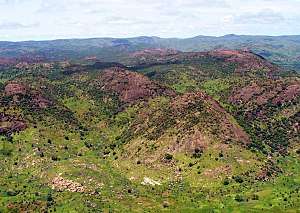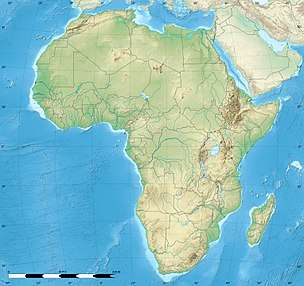Nuba Mountains
The Nuba Mountains, also referred to as the Nuba Hills (Arabic: جبال النوبة), is an area located in South Kordofan, Sudan. The area is home to a group of indigenous ethnic groups known collectively as the Nuba peoples. In the Middle Ages, the Nuba mountains probably had been part of the Nubian kingdom of Alodia.[1] In the 18th century, they became home to the kingdom of Taqali that controlled the hills of the mountains until their defeat by Mahdi Muhammad Ahmad. After the Mahdi's defeat by the British, Taqali was restored as a client state. Infiltration of the Messiria tribe of Baggara Arabs has been influential in modern conflicts.
| Nuba Mountains | |
|---|---|
| جبال النوبة Jabal an-Nūbā | |
 The Nuba Mountains | |
| Highest point | |
| Elevation | 1,325 m (4,347 ft) |
| Coordinates | 12°1′N 31°6′E |
| Dimensions | |
| Length | 145 km (90 mi) |
| Width | 64 km (40 mi) |
| Geography | |
 Location in Africa | |
| Country | Sudan, South Sudan |
| Region | South Kordofan |
.jpg)
Geography
The mountains cover an area roughly 64 km wide by 145 km long (40 by 90 miles), and are 450 to 900 meters (1,500 to 3,000 feet) higher in elevation than the surrounding plain. The mountains stretch for some 48,000 square kilometers (19,000 square miles).[2] The climate is tropical, hot semi-arid with 300 to 800 mm of rain per year on average, but lush and green compared with most nearby areas. There are almost no roads in the Nuba Mountains; most villages there are connected by ancient paths that cannot be reached by motor vehicle. The rainy season extends from mid-May to mid-October, and annual rainfall ranges from 300 to 800 millimeters, allowing grazing animals and seasonal rain-fed agriculture.
Political status
The region stayed under the control of the central government and the Comprehensive Peace Agreement did not give the Nuba Mountains the right to join South Sudan in its vote for independence in 2011. Residents of the Nuba Mountains were required to hold ill-defined "popular consultations" to determine their future.[3][4] Not only the Nuba Mountains but the whole of South Kordofan state would be eligible to vote, essentially to accommodate the Messiria.[5] Additionally, the Sudanese government maintained a heavy military presence in the region and even prospective "popular consultations" were seen likely to be barred.[5] The ambiguous situation and fears of future communal violence invoked concerns that South Kordofan could be the "next Darfur".[6][7][8]
As of June 2011, South Kordofan's governor Ahmed Haroun had suspended the process of popular consultations and conflict between Sudan People's Armed Forces and Nuba fighters of the SPLM-N followed[9] (see Sudan–SPLM-N conflict (2011)).
The war in Sudan began in 1983 until the Comprehensive Peace Agreement (CPA) signed on 9 January 2005 with independence vote set for 9 July 2011-the vote on 9 July 2011 succeeded the south into Africa's newest country, the Republic of South Sudan. The capital is located in Juba. The Nuba Mountains are geographically in the north in the area called South Kordofan (see Wikipedia for in-depth review). The people of the Nuba Mountains (a five mountain chain rising from the desert to 1,000 metres (3,000 feet)) were not aligned with the north under sharia law nor the Arabic language. This cultural dispute was in part the reason for people in Nuba being prosecuted by indiscriminate bombing, attacks on civilians and mines at entry points to the Nuba Mountains. In 2002, due to the extreme starvation of the people of the Nuba Mountains and under the international pressure from the UN, Khartoum under President Bashir (at that time, the government was termed the National Islamic Front) authorizes an interim cease fire to provide food and medical equipment/support to the people of the Nuba Mountains. In exchange, the Sudan People's Liberation Army/SPLA agree not attack the south-north pipeline to Port Sudan on the Red Sea coast. An international group of observers/advisers deployed to South Kordofan Province/Kadugli with several US advisers deployed directly into the Nuba Mountains, specifically to be co-located with the SPLA. One of the advisers/observers was Randolph Hampton (US) located in Kauda co-located with the SPLA command element. Reports of indiscriminate bombing of civilians and mining entry points primarily for relief operation was reported and documents (with photos) during this time. Abdel Aziz Adam El Hilu was at that time, the governor of the Nuba Mountains and former military leader for the SPLA. He is currently (as of March 2012) back in the Nuba Mountains supporting relief and security operations.
The international community, including a number of celebrities such as actor George Clooney[10] and reporter Nicholas Kristof,[11] have recently travelled to the Nuba Mountains and documented the continued genocidal activities of the Bashir government. President Bashir is an indicted war criminal at the International Criminal Court (ICC) as a result of the genocidal activities of Sudan in Darfur. Human Rights Watch says that cluster bombs are used in the region.[12]
The ongoing war continues as the international community continues to debate a resolution to the issue of the Nuba Mountains.[13]
References
- Spaulding 1998, p. 49.
- "BBC News - Will Sudan's Nuba Mountains be left high and dry?". bbc.co.uk.
- Will Sudan's Nuba Mountains be left high and dry? by Peter Martell, BBC News, 24 November 2009
- SUDAN: The Nuba Mountains - straddling the north-south divide, IRIN, 12 November 2009
- "Why are the Nuba of Sudan Protesting? by Suleiman Musa Rahhal, FIBMS". sudaneseonline.com.
- Sudan's Southern Kordofan Problem: The Next Darfur?, International Crisis Group report, 21 October 2008
- The Daily Telegraph: "New war in Sudan's Nuba mountains?" November 4, 2009.
- BBC: "Sudan: Could Nuba mountains be next conflict?" May 10, 2011
- "Is Sudan heading for an acrimonious divorce?". BBC News.
- "George Clooney Puts 'Spotlight' on Bloodshed, Crisis in Sudan's Nuba Mountains". PBS NewsHour.
- A rain of bombs in the Nuba
- "Sudan: Cluster Bombs Used in Nuba Mountains". Human Rights Watch.
- Al Jazeera: "Eyes of Nuba - Armed with a camera, Ahmed Khatir sets out to tell the story of a war that hardly anyone has heard of" 27 January 2014
Literature
- Spaulding, Jay (1998). "Early Kordofan". In Endre Stiansen and Michael Kevane (ed.). Kordofan Invaded: Peripheral Incorporation in Islamic Africa. Brill. pp. 46–59. ISBN 9004110496.CS1 maint: ref=harv (link)
Further reading
- Erwald, Janet J. Soldier, Traders, and Slaves: State Formation and Economic Transformation in the Greater Nile Valley, 1700-1885. University of Wisconsin. ISBN 0-299-12604-8.CS1 maint: ref=harv (link)
- Spaulding, Jay (1987). "A Premise for Precolonial Nuba History". History in Africa. Cambridge University. 14. doi:10.2307/3171848.CS1 maint: ref=harv (link)
External links

- The Nuba Mountains Homepage
- The Nuba Survival Association
- Varhola, Christopher H. - Cows, Korans, and Kalashnikovs: The Multiple Dimensions of Conflict in the Nuba Mountains of Central Sudan Department of Anthropology, The Catholic University of America, September 2002. (at the Wayback Machine)
- Nubawatch: "Nuba Mountains: The Beginning" January 9, 2011.
- Al Jazeera: "In Pictures: Sudan's mountain refuges" March 23, 2012
- Full documentary about Nuba sufferings in the Nuba Mountains
- New York Times: "The Worst Atrocity You’ve Never Heard Of" By Adam B. Ellick July 13, 2015